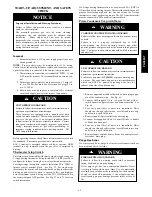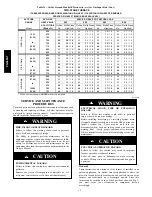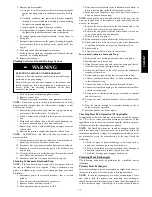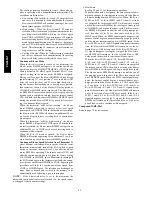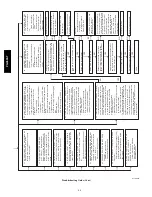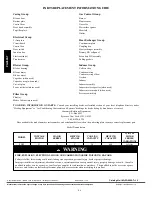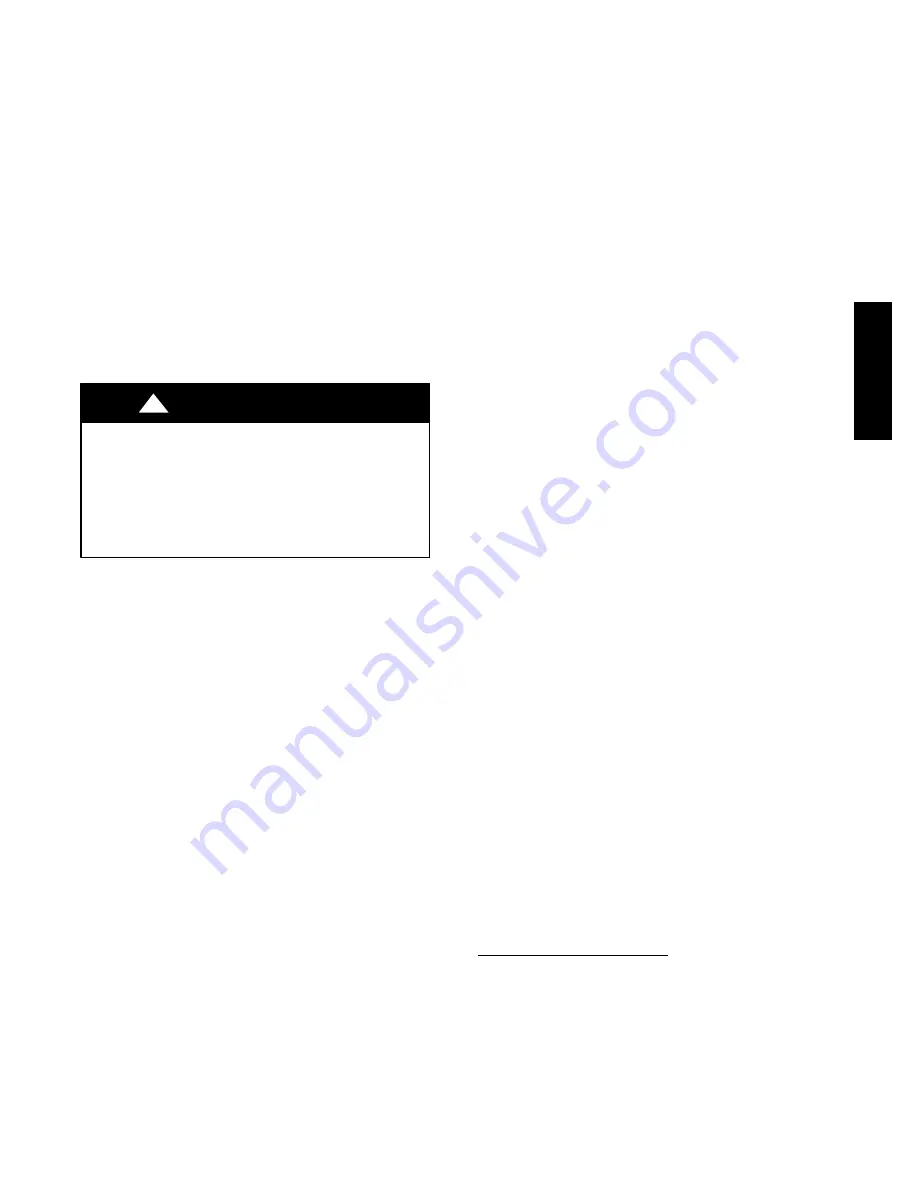
77
5. Remove igniter assembly.
a. Using a 1/4--in. driver, remove the two screws securing the
igniter mounting bracket to the burner assembly See Fig.
69.
b. Carefully withdraw the igniter and bracket assembly
through the front of the burner assembly without striking
the igniter on surrounding parts.
c. Inspect igniter for signs of damage or failure.
d. If replacement is required, remove the screw that secures
the igniter on igniter bracket and remove the igniter.
6. To replace igniter and bracket assembly, reverse items 5a
through 5d.
7. Reconnect igniter harness to the igniter, dressing the igniter
wires to ensure there is no tension on the igniter itself. See
Fig. 69.
8. Turn on gas and electrical supplies to furnace.
9. Verify igniter operation by initiating control board self--test
feature or by cycling thermostat.
10. Replace control door.
Flushing Collector Box and Drainage System
ELECTRICAL SHOCK AND FIRE HAZARD
Failure to follow this warning could result in personal injury,
death, and/or property damage.
Turn off the gas and electrical supplies to the furnace and
install lockout tag before performing any maintenance or
service. Follow the operating instructions on the label
attached to the furnace.
!
WARNING
1. Turn off gas and electrical supplies to furnace.
2. Remove control door.
3. Disconnect pressure switch tube from pressure switch port.
NOTE:
Ensure the pressure switch tube disconnected from the
pressure switch is higher than the collector box opening or water
will flow out of tube.
4. Remove the collector box plug from the top port on the up-
per corner of the collector box. See Fig. 66.
5. Attach a funnel with a flexible tube to port on the collector
box.
6. Flush inside of collector box with water until discharge wa-
ter from condensate trap is clean and runs freely.
7. Repeat steps 4 thru 6 with middle plug on upper corner of
collector box.
8. Remove the pressure switch tube from the collector box.
NOTE
: Do
NOT
blow into tube with tube connected to the
pressure switch.
9. Clean pressure switch port on collect box with a small wire.
Shake any water out of pressure switch tube.
10. Reconnect tube to pressure switch and pressure switch port.
11. Remove the relief tube from the port on the collector box
and the trap.
12. Clean the relief port on collect box and the trap with a small
wire. Shake any water out of the tube.
13. Reconnect relief tube to trap and collector box ports.
Cleaning Condensate Drain and Trap
NOTE
: If the condensate trap is removed, a new gasket between
the trap and collector box is required. Verify a condensate trap
gasket is included in the service kit or obtain one from your local
distributor.
1. Disconnect power at external disconnect, fuse or circuit
breaker.
2. Turn off gas at external shut-off or gas meter.
3. Remove control door and set aside.
4. Turn electric switch on gas valve to OFF.
5. Disconnect external drain from condensate drain elbow or
drain extension pipe inside the furnace and set aside.
6. Disconnect the condensate trap relief hose from collector
box port and condensate trap.
NOTE
: If condensate has a heat pad attached to the trap, trace the
wires for the pad back to the connection point and disconnect the
wires for the heat pad.
7. Remove the screw that secures the condensate trap to the
collector box, remove the trap and set aside.
8. Remove the trap gasket from the collector box if it did not
come off when the trap was removed.
9. Discard the old trap gasket.
10. Rinse condensate trap in warm water until trap is clean.
11. Flush condensate drain lines with warm water. Remember
to check and clean the relief port on the collector box.
12. Shake trap dry.
13. Clean port on collector box with a small wire.
To re-install Condensate Drain and Trap:
1. Remove adhesive backing from condensate trap gasket
2. Install gasket on collector box
3. Align the condensate trap with the drain opening on the col-
lector box and secure the trap with the screw
4. Attach the relief hose to the relief port on the condensate
trap and collector box.
5. Secure tubing to prevent any sags or traps in the tubing.
6. Connect condensate drain elbow or drain extension elbow
to the condensate trap
7. Connect the leads of the condensate heat pad (if used)
8. Connect external drain piping to the condensate drain elbow
or drain extension pipe.
9. Turn gas on at electric switch on gas valve and at external
shut-off or meter
10. Turn power on at external disconnect, fuse or circuit break-
er.
11. Run the furnace through two complete heating cycles to
check for proper operation
12. Install control door when complete.
Checking Heat Pad Operation (If Applicable)
In applications where the ambient temperature around the furnace
is 32
_
F or lower, freeze protection measures are required. If this
application is where heat tape has been applied, check to ensure it
will operate when low temperatures are present.
NOTE:
The Heat Pad, when used, should be wrapped around the
condensate drain trap. There is no need to use heat tape within the
furnace casing. Most heat tapes are temperature activated, and it is
not practical to verify the actual heating of the tape. Check the
following:
1. Check for signs of physical damage to heat tape such as
nicks, cuts, abrasions, gnawing by animals, etc.
2. Check for discolored heat tape insulation. If any damage or
discolored insulation is evident, replace heat tape.
3. Check that heat tape power supply circuit is on.
Cleaning Heat Exchangers
The following items must be performed by a qualified service
technician.
Primary Heat Exchangers
If the heat exchangers get an accumulation of light dirt or dust on
the inside, they may be cleaned by the following procedure:
NOTE:
If the heat exchangers get a heavy accumulation of soot
and carbon, both the primary and secondary heat exchangers
should be replaced rather than trying to clean them thoroughly due
to their intricate design. A build--up of soot and carbon indicates
PG95X
AT

